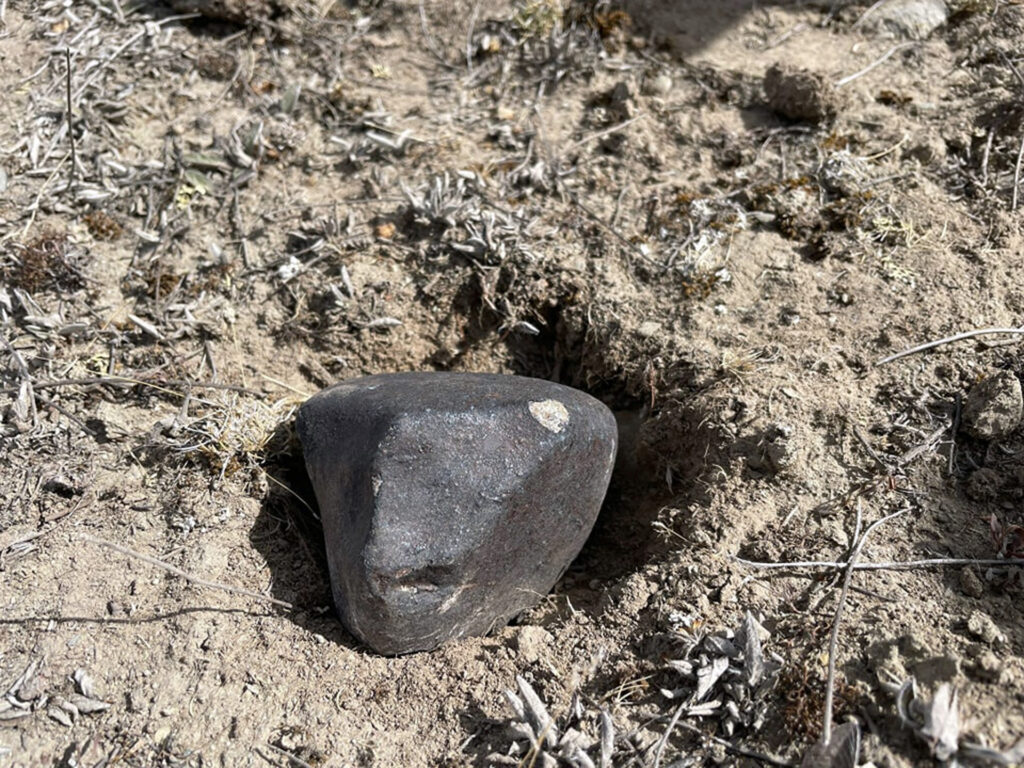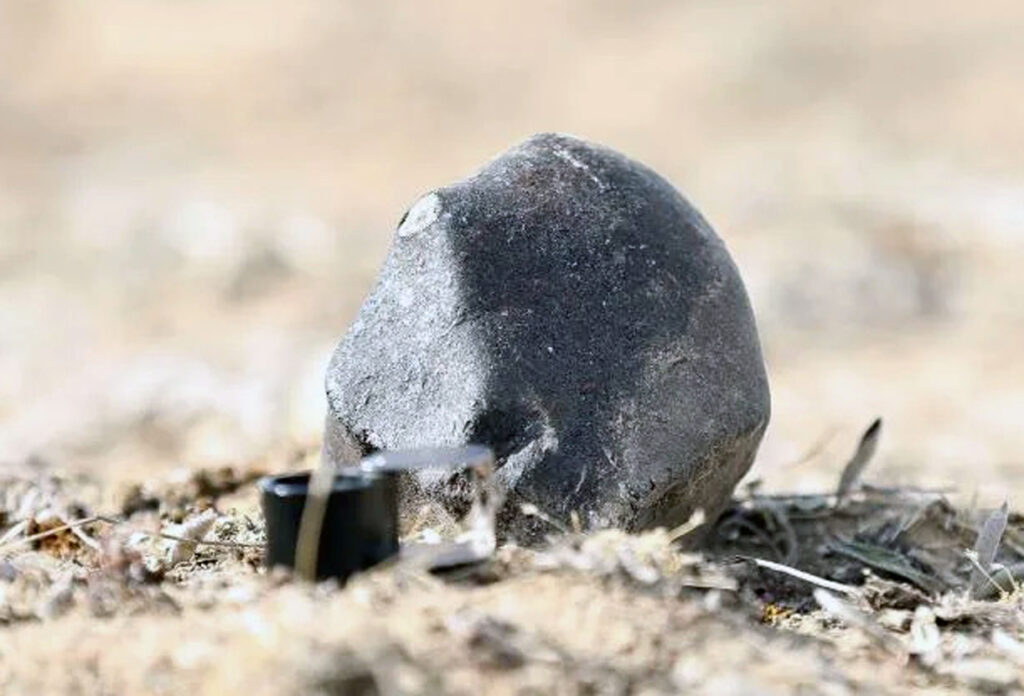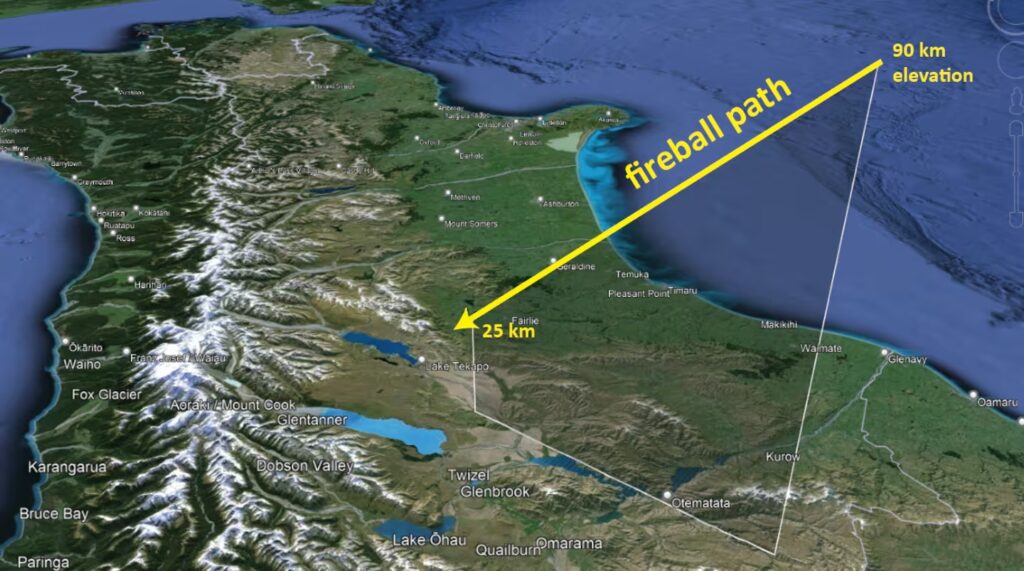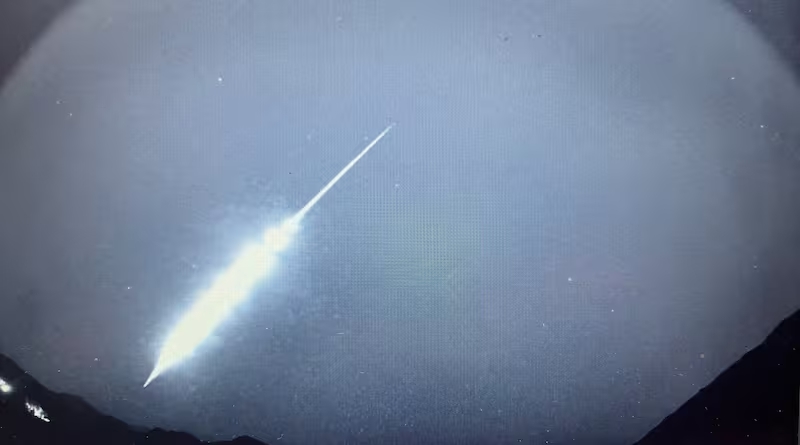Takapō meteorite (810 g, L5, S5/6) of bolide at 21:04:10 NZDT (08:04:10 UTC) on 13 March 2024 found south of Lake Takapō/Tekapo, Mackenzie Basin, Canterbury, New Zealand
Last update: 25 May 2025, 12:30 CEST
An apple-sized 810-gram meteorite (L5, S5/6) of the bolide on 13 March 2024 has been found by 29-year old voluteer Jack Weterings from Wellington at location 44°06.009960’S, 170°25.024080’E, on public DOC land, a glacial plain south of Lake Takapō/Tekapo, Mackenzie Basin, Canterbury, New Zealand in the morning of 21 March 2024. The meteorite was found among local greywacke during a public meteorite search expedition after about 10 to 20 minutes while the members of the Fireballs Aotearoa search team were on their way to the calculated search area where they hoped to find a meteorite of about 0.6 to 1.6 kilogram (nominal mass of 0.9 kg). Members of the search team were S. Adam, A. Barrajun, D. Behan, W. Chang, S. Eberlin, E. Gapper, E. Gapper, M. Gapper, Z. Gapper, A. Gilmore, P. Gilmore, T.Y. Lin, S. Robb, G. Rocord, P. Silva, R. McCarthy, M. Midgley, A. Muner, M. Palmer, T. Richarson, M. Stroinigg, J. Weterings, H. Williams, M. Williams, S. Wilson S. Wyn-Harris, and M. Ying. Using data from NZ0015, NZ000T (Fiordland College, Te Anau), NZ000S (Maniototo Area School, Ranfurly), and NZ000D (Oamaru North, Oamaru) Denis Vida, Jesse Stayte and Peter McKellar calculated the atmospheric trajectory and preatmospheric orbit. Data from the weather station data from Invercargill were used to calculate the dark flight trajectory. On 16 March Dennis Behan and Marshall Palmer explored the area during a first reconnaissance search expedition. The meteorite was reportedly found about 11.8 kilometres south-southwest of Lake Takapō/Tekapo outside the designated search area and it left a shallow impact dent in the hard ground. The meteoritic nature of the find was confirmed in the field by University of Otago geologist Marshall Palmer after examining it with a hand held XRF device. The finder has relinquished any and all ownership rights to Fireballs Aotearoa. The meteorite has been sent to University of Otago for further analysis. A 3D scan of the meteorite has been or will be made. Plaster casts of the impact pit have been made by Damien McNamara and he also captured the impact site via photogrammetry. The fall location itself has been marked with a ring of stones. The Fireballs Aotearoa camera network had recorded the 6.72-second bolide’s luminous trail from an altitude of about 96 km (speed 18 km/s) down to 23.3 km where it had slowed down to 5 km/s and entered the dark flight trajectory. An eyewitness from Twizel (Canterbury), about 41 kilometres southwest from the fall site, reports having heard “a long loud continuous thunder-like boom followed by a crashing sound and shaking”. Fireballs Aotearoa has calculated an inner solar system Aten-type preatmospheric orbit. From 5:30 pm to 6:30 pm NZDT on 2 April 2024 Dr Marshall Palmer, Steve Wyn-Harris and Dennis Behan were giving a free public talk on the meteorite fall at Tūhura Otago Museum ‘s Hutton Theatre in Dunedin. During the talk the meteorite was shown to the public for the first time. A 3D scan of the meteorite was done before it was decided where to cut off chunks for the classification and radiometric dating of the meteorite. The meteorite’s remaining main mass (720.38 g) and four fragments cut from it (11.52 g, 3.59 g, 4.83 g, 4.54 g) are curated at Tūhura Otago Museum and three fragments (5.3 g, 4.91 g, 1.4 g) are curated at Otago University. On 18 October 2024 the fall was officially registered as Takapō (L5, W0) in the Meteoritical Bulletin Database.

The meteorite in-situ. Photo: Fireballs Aotearoa

The Takapō meteorite inside its impact pit. Photo: Marina Stroinigg

The meteorite in-situ in its impact pit at 10:17 am local on 21 March 2024. Photo: Fireballs Aotearoa
The Takapō meteorite. Photo: Marina Stroinigg
The Takapō meteorite. Photo: Marshall Palmer

Photo: Steve Wyn-Harris/ Fireballs Aotearoa

The meteorite at its fall site. Photo: Aiman Amerul Muner
Photo: Fireballs Aotearoa

Photo: Fireballs Aotearoa

Photo: Fireballs Aotearoa

The Takapō meteorite fall site. Photo: Marina Stroinigg
Photogrammetry rendering of the impact site. Video: Damien McNamara

The Takapō meteorite at Tūhura Otago Museum on 2 April 2024. Photo: Ian Griffin
THE BOLIDE
The bolide (AMS event 1392-2024) was visible for 6.72 seconds and was recorded from the National Institute Of Water and Atmospheric Research (NIWA) in Lauder, New Zealand, at location 45°02’16.3″S, 169°40’59.1″E, ~130 kilometres south-southwest of Lake Tekapo. Video: Allsky7 (AMS247), Richard Querel (NIWA), James Scott
The bolide (AMS event 1392-2024) was visible for 6.72 seconds and was recorded from the National Institute Of Water and Atmospheric Research (NIWA) in Lauder, New Zealand, at location 45°02’16.3″S, 169°40’59.1″E, ~130 kilometres south-southwest of Lake Tekapo. Video: Allsky7 (AMS247), Richard Querel (NIWA), James Scott
Calculated trajectory of the luminous trail and designated search area south of Lake Takapō/Tekapo. Image: Fireballs Aotearoa

The New Zealand camera network and the trajectory of the Tekapo (prov.) bolide. Image: Fireballs Aotearoa
The bolide as recorded by Dennis Behan’s Global Meteor Network camera NZ0015 at Arthurs Point, Queenstown (44°59’08.7″S, 168°40’46.2″E) , about 175 kilometres southwest from the approximate find location of the meteorite. Video: Dennis Behan
Cumulative image of the bolide as recorded by Dennis Behan’s Global Meteor Network camera NZ0015 at Arthurs Point, Queenstown , about 175 kilometres southwest from the approximate find location of the meteorite. Photo: Dennis Behan
Trajectory calculation has used visual data from these Global Meteor Network cameras: NZ0015 (44°59’08.7″S, 168°40’46.2″E), about 175 kilometres southwest from the approximate find location of the meteorite, NZ000S 45°07’31.5″S, 170°05’57.5″E , about 124 kilometres south-southwest from the approximate find location of the meteorite, NZ000T 45°24’35.4″S, 167°43’27.6″E , about 263.5 kilometres southwest from the approximate find location of the meteorite, and NZ000D ~ 45°04’00.1″S, 170°59’14.8″E about 122 kilometres south-southeast from the approximate find location of the meteorite.

Skyfit2-Modelling of the trajectory. Velocity and time of the fireball, as determined from camera NZ000S, D, T and 15. Image: Fireballs Aotearoa
THE ORBIT

The calculated orbit of the rock that formed the meteor is shown in green. Earth (blue), Venus (yellow), Mars (red). Image: Fireballs Aotearoa
MEDIA
Video: 1News (22 March 2024)
Video: Newshub (22 March 2024)
The Country (22 March 2024), Interview with Steve Wyn-Harris
TV report about the find of the meteorite (Stuff, 21 March 2024). Video: Aiman Amerul Muner
LINKS
New Zealand’s meteor camera network leads to recovery of the Tekapo/Takapō meteorite (26 March 2024)





































